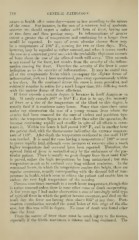Page 708 - My FlipBook
P. 708
718 GENERAL PATHOLOGY.
return to health after some days—more or less according to the nature
of tlie cause. For instance, in the case of a common boil of moderate
severity we should expect a rather mild form of fever, lasting one
or two days and then passing away. In inflammations of greater
extent a greater rise of temperature and continuing for a longer time
would be expected. In cases of acute alveolar abscess there may
be a temperature of 104° F., running for two or three days. This,
however, may be regarded as rather unusual, and when it occurs marks
the case as a somewhat grave one, with the j)robability that some necrosis
of bone about the root of the affected tot)th will occur. This necrosis
is not caused by the fever, but results from the severity of the inflam-
mation causing the fever. Therefore the severity of the fever is some
indication as to the severity of inflammations. It may be stated that
all of the symptomatic fevers which accompany the slighter forms of
inflammation, such as I have mentioned, pass away spontaneously within
a few days. In the continued fevers the cause is more persistent, and
evidently remains in action for a nuich longer time, this differing much
with the various forms of these aflections.
If fever exceeds a certain degree, it becomes in itself dangerous to
life. It rarely exceeds 107° or 108° F. ; that is to say, this intensity
of fever, or a rise of the temperature of the blood to this degree, is
usually fatal if it continues many hours. Some time since there came
under my observation the case of a young woman from whom the
ovaries had been removed for the cure of \iolent and persistent hys-
teria: the temperature began to rise a short time after the operation, the
increase continuing rapidly and steadily in spite of all efforts to coun-
teract it. Within ten hours it had passed 108° F., and in another hour
the patient died, with the thermometer indicating the extreme tempera-
ture of 110°. After death the temperature continued to rise until 112°
was reached. It is usual for cases having a temperature of 108° or over
to prove rapidly fatal, although some instances of recovery after a much
higher temperature had occurred have been reported. Therefore, the
upward limit of fever is controlled only by the endurance of the par-
ticular ])atient. There is usually no great danger from fever until 106°
is passed, unless the high temperature be long maintained ; but this
temperature is not to be endured very long without remission. In the
continued fevers, in M'hich the temperature reaches this height, there are
regular remissions, usually corresponding with the diurnal fall of tem-
perature in health, which seem to relieve the patient and enable him to
endure the very high temperature of the evening.
Persons sometimes succumb to a much lower temperature, though this
is rather unusual unless there is some other cause of death co-operating.
A few years ago I had under observation a case of seemingly mild type
of typhoid fever in which the patient became comatose, and died on the
tenth day, the fever not having risen above 103° at any time. Post-
mortem examination revealed the usual lesion of this stage of the dis-
ease, but this was mild in degree. Xo cause of death was found other
than the fever.
From the nature of fever there must be much injury to the tissues,
especially if the febrile movement is intense and long continued. The


